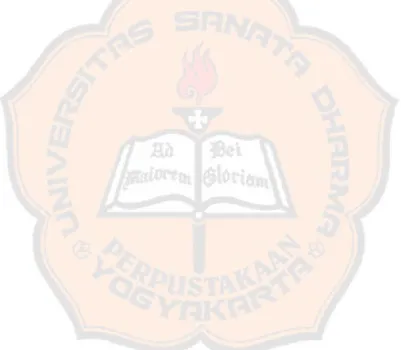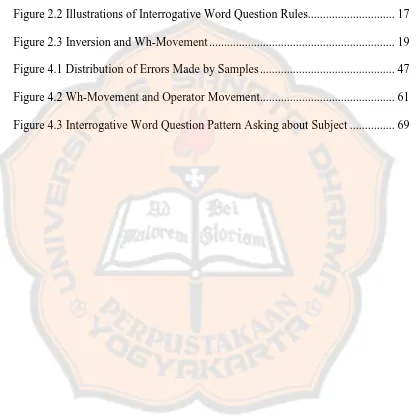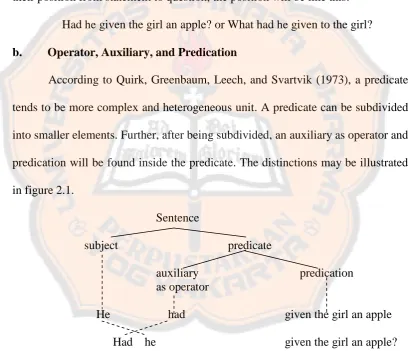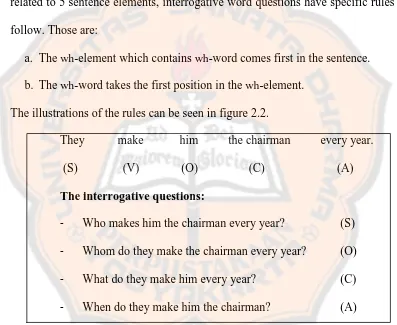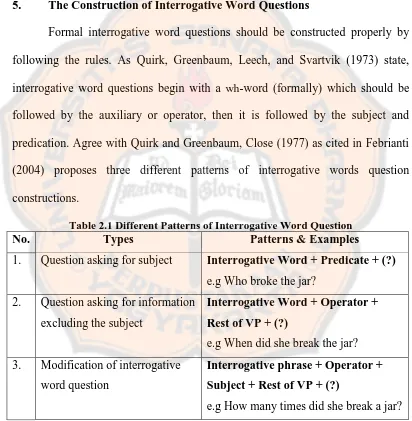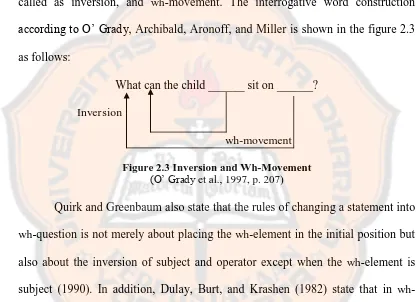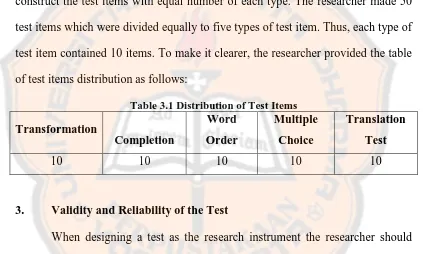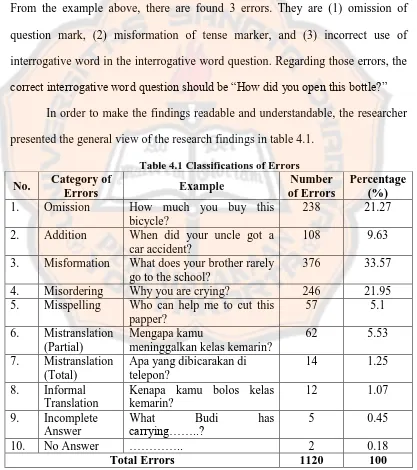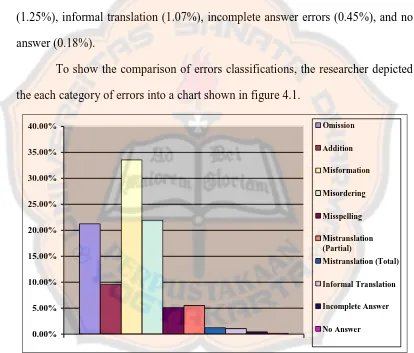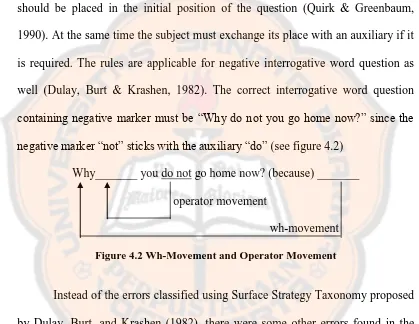CONSTRUCTIONS MADE BY MATHEMATICS EDUCATION
STUDENTS OF SANATA DHARMA UNIVERSITY
BATCH 2010
A SARJANA PENDIDIKAN THESIS
Presented as Partial Fulfillment of the Requirements to Obtain the Sarjana Pendidikan Degree
in English Language Education
By Wahyuningtyas Student Number: 081214077
ENGLISH LANGUAGE EDUCATION STUDY PROGRAM DEPARTMENT OF LANGUAGE AND ARTS EDUCATION FACULTY OF TEACHERS TRAINING AND EDUCATION
SANATA DHARMA UNIVERSITY YOGYAKARTA
i
CONSTRUCTIONS MADE BY MATHEMATICS EDUCATION
STUDENTS OF SANATA DHARMA UNIVERSITY
BATCH 2010
A SARJANA PENDIDIKAN THESIS
Presented as Partial Fulfillment of the Requirements to Obtain the Sarjana Pendidikan Degree
in English Language Education
By Wahyuningtyas Student Number: 081214077
ENGLISH LANGUAGE EDUCATION STUDY PROGRAM DEPARTMENT OF LANGUAGE AND ARTS EDUCATION FACULTY OF TEACHERS TRAINING AND EDUCATION
SANATA DHARMA UNIVERSITY YOGYAKARTA
iv
Life
Life is an opportunity, benefit from it
Life is beauty, admire it
Life is a dream, realize it
Life is a challenge, meet it
Life is a duty, complete it
Life is a game, play it
Life is a promise, fulfill it
Life is a sorrow, overcome it
Life is a song, sing it
Life is a struggle, accept it
Life is a tragedy, confront it
Life is an adventure, dare it
Life is luck, make it
Life is too precious, do not destroy it
Life is life, fight for it
~Mother Teresa~
v
I honestly declare that this thesis, which I have written, does not contain the work or parts of the work of other people, except those cited in the quotations and the references, as a scientific paper should.
Yogyakarta, August14, 2013 The Writer
vi
PUBLIKASI KARYA ILMIAH UNTUK KEPENTINGAN AKADEMIS
Yang bertandatangan di bawah ini, saya mahasiswa Universitas Sanata Dharma
Nama : Wahyuningtyas
Nomor Mahasiswa : 081214077
Demi pengembangan ilmu pengetahuan, saya memberikan kepada Perpustakaan Universitas Sanata Dharma karya ilmiah saya yang berjudul:
ERRORS IN INTERRROGATIVE WORD QUESTION
CONSTRUCTIONS MADE BY MATHEMATICS EDUCATION
STUDENTS OF SANATA DHARMA UNIVERSITY
BATCH 2010
beserta perangkat yang diperlukan (bila ada). Dengan demikian saya memberikan kepada Perpustakaan Universitas Sanata Dharma hak untuk menyimpan, mengalihkan dalam bentuk media lain, mengelolanya dalam bentuk pangkalan data, mendistribusikan secara terbatas, dan mempublikasikannya di internet atau media lain untuk kepentingan akademis tanpa perlu meminta ijin dari saya maupun memberikan royalti kepada saya selama tetap mencantumkan nama saya sebagai penulis.
Demikian pernyataan ini saya buat dengan sebenarnya. Dibuat di Yogyakarta
Pada tanggal: 14 Agustus 2013 Yang menyatakan
vii
Wahyuningtyas. 2013. Errors in Interrogative Word Question Constructions Made by Mathematics Education Students of Sanata Dharma University Batch 2010. Yogyakarta: English Language Education Study Program, Sanata Dharma University.
English is considered a foreign language which should be learnt by Indonesian students as part of communicative competence. However, since English grammar and vocabulary are different from Bahasa Indonesia, it is still problematic for Indonesian students to use English properly. Mostly, it is quite difficult and confusing for Indonesian students in general to construct English questions which require specific rules. As a result, most Indonesian students still make errors constructing English questions appropriately.
The researcher aimed to investigate the errors in English question constructions especially the interrogative word questions which are commonly used in communication. There are two research questions proposed in this study: (1) What errors in interrogative word question formations are made by the samples of research? (2) What are the sources of errors in interrogative word constructions made by the samples of research?
The researcher conducted survey research by using a test as the instrument to answer both research questions. The data gathered from the test were analyzed based on Surface Strategy Taxonomy to define errors made by the samples of research, which were Mathematics Education Students of Sanata Dharma University batch 2010. Further, the errors that had been classified were analyzed based on the characteristics including the patterns to determine the sources of errors.
The findings showed that the most frequent errors in interrogative word question constructions made by the samples of research belonged to misformation (33.57%), and were followed subsequently by misordering (21.95%), omission (21.27%), addition (9.63%), partial mistranslation (5.53%), misspelling (5.1%), total mistranslation (1.25%), informal translation (1.07%), incomplete answer (0.45%), and finally no answer (0.18%). Based on the analysis on the characteristics of errors, there were found 4 sources of errors. They were (1) interference of mother tongue, (2) lack understanding of target language, (3) communication strategy, and (4) avoidance.
Following the findings and conclusions the researcher proposes some suggestions addressed to the teachers, students, and the future researchers who have interest in similar topic and issue. The suggestions are related to how teachers should deal with teaching learning methods and activities to improve
students’ English proficiency, how students should enhance themselves in learning language, and how the future researchers should conduct further research on the similar topic.
viii
Wahyuningtyas. 2013. Errors in Interrogative Word Question Constructions Made by Mathematics Education Students of Sanata Dharma University Batch 2010. Yogyakarta: Program Studi Pendidikan Bahasa Inggris, Universitas Sanata Dharma.
Bahasa Inggris adalah salah satu bahasa asing yang wajib dipelajari oleh pelajar di Indonesia sebagai bagian dari kompetensi komunikatif. Akan tetapi, karena tata bahasa (grammar) dan perbendaharaan kata dalam Bahasa Inggris berbeda dengan Bahasa Indonesia, banyak pelajar di Indonesia yang masih bermasalah dengan penggunaan bahasa Inggris yang tepat. Lebih-lebih, cukup sulit bagi pelajar di Indonesia secara umum untuk dapat menyusun kalimat tanya menggunakan bahasa Inggris dengan tepat. Hasilnya, masih banyak pelajar yang membuat berbagai jenis kesalahan dalam penyusunan kalimat tanya tersebut.
Peneliti bermaksud untuk menyelidiki kesalahan-kesalahan dalam penyusunan kalimat tanya dengan menggunakan bahasa Inggris, khususnya pada kalimat interogatif yang seringkali digunakan dalam berkomunikasi. Ada dua pertanyaan yang diajukan dalam penelitian ini: (1) Apa saja kesalahan-kesalahan yang terdapat dalam kalimat interogatif yang dibuat oleh sampel penelitian? (2) Apa saja sumber yang menyebabkan terjadinya kesalahan dalam penyusunan kalimat interogatif oleh sampel penelitian?
Guna menjawab kedua pertanyaan yang diajukan dalam penelitian ini, peneliti melaksanakan survey research dengan menggunakan sebuah tes sebagai instrumen penelitian. Data yang terjaring dari penelitian kemudian dianalisa berdasarkan Surface Strategy Taxonomy untuk menemukan jenis kesalahan yang dibuat oleh sampel, yaitu mahasiswa Pendidikan Matematika Universitas Sanata Dharma angkatan 2010. Selanjutnya kesalahan tersebut dianalisa berdasarkan karakteristiknya untuk menemukan sumber-sumber penyebabnya.
Jenis kesalahan yang paling banyak ditemukan di dalam penelitian termasuk dalam kategori misformation (33,57%), misordering (21,95%), omission (21,27%), addition (9,63%), partial mistranslation (5,53%), misspelling (5,1%), total mistranslation (1,25%), informal translation (1,07%), incomplete answer (0,45%), dan no answer (0,18%). Secara garis besar kesalahan tersebut disebabkan oleh 4 sumber, yaitu: (1) pengaruh bahasa ibu, (2) kekurangpahaman terhadap bahasa target, (3) strategi komunikasi yang tidak tepat, dan (4) penolakan terhadap aturan dan tata bahasa yang baku.
Peneliti tak lupa pula memberikan beberapa saran yang membangun. Peneliti memberi saran kepada para guru agar lebih selektif dalam memilih metode dan aktivitas pembelajaran yang sesuai guna meningkatkan kemampuan berbahasa Inggris siswa. Selanjutnya, peneliti menyarankan agar para siswa mau dan mampu mengembangkan kemampuan bahasa Inggris mereka secara mandiri. Peneliti juga menyarankan agar para calon peneliti mampu mengadakan penelitian dengan lebih memperluas pokok pembahasan mengenai topik yang serupa.
ix
First of all, I would like to send my biggest grateful to my savior, Jesus Christ, as He always pours me abundant love and spirit and Mother Mary as She always helps me to make anything possible. Secondly, I would like to present my sincere appreciation to my thesis advisor, Barli Bram for his enduring guidance, support, suggestions, and reinforcement which are valuable for my thesis.
I am also abundantly indebted to Ibu Chatarina Enny Murwaningtyas, S.Si., M.Si. as the vice chairperson of Mathematics Education Study Program of Sanata Dharma University who has permitted me to conduct a research on her students. The next great thankfulness I present to the Mathematics Education students of Sanata Dharma University batch 2010 for being cooperative and friendly during the research.
My biggest gratitude is presented to my beloved family. I thank my wonderful parents, Bapak Wahada and Ibu Yustina Sugiyah for everything they give sincerely to me, their love, patience, support, and advices. The next gratefulness belongs to my beloved brother, Albertus Ganda Pangestu, for his jokes, love, care, laughter, spirit, and kindness. My profound thanks are presented to Pakdhe Sugiyo, Budhe Ani, Mbak Mega, Mas Jati Primandaru, Mbak Reni, Simbah Udi Utomo for their support and reminder to finish my thesis as soon as possible.
x
at Sanata Dharma University. I owe a great debt to Roandryo Sigma P. Surbakti, S.Pd and Frater Paulus Halek, SS. CC. for their sincere willingness to be the proof readers of my thesis. The next gratitude is addressed to PBI Secretariat staff, Mbak Dhanniek and Mbak Tari for their best services and unlimited help.
My deepest gratitude goes to my awesome friends in PBI especially Windru Oktarine, Elisabet Deti Kurniawati, Patricia Yuristavia, who become my best friends in PBI until now on. Sincerely, I thank Siska, Atma, Greg, Vita, Lia and Widi for being my great thesis partners. I also thank Mbak Elisabet Indah, Mbak Reko, and Mas Dwi from PBI batch 2007 for their support, advice, and laughter. The next great gratefulness goes to Romo F. Hartanta, Pr. for his unlimited support and encouragement. I also thank my great friends, Ancelmatini
“Mami” Nur Wulandari, Mbak Valentina Wati, and Mas Henricus Eko
“Ndut” for their kindness and support.
Not to forget, I also express my deepest thankfulness to all the lecturers in PBI, all of my PBI friends from batch 2008 and all people I have met in Sanata Dharma University whose name I could not mention one by one. I am very grateful and blessed to meet all of them.
xi
Page
TITLE PAGE ... i
APPROVAL PAGE ... ii
DEDICATION PAGE ... iv
STATEMENT OF WORK’S ORIGINALITY ... v
PERNYATAAN PERSETUJUAN PUBLIKASI ... vi
ABSTRACT ... vii
ABSTRAK ... viii
ACKNOWLEDGEMENTS ... ix
TABLE OF CONTENTS ... xi
LIST OF TABLES ... xiv
LIST OF FIGURES ... xv
LIST OF APPENDICES ... xvii
CHAPTER I. INTRODUCTION ... 1
A. Research Background ... 1
B. Problem Formulation ... 5
C. Problem Limitation ... 6
D. Research Objectives ... 6
E. Research Benefits ... 7
xii
A. Theoretical Description ... 11
1. The Nature of Interrogative Word Questions... 11
2. The Identification of Interrogative Word Questions ... 12
3. The Sentence Construction in English ... 15
4. The Rules of Interrogative Word Question Constructions ... 16
5. The Construction of Interrogative Word Questions ... 18
6. Language Errors ... 20
7. Sources of Errors ... 25
8. Error Analysis ... 26
9. Survey Research ... 27
B. Theoretical Framework ... 28
CHAPTER III. METHODOLOGY ... 30
A. Research Method ... 30
B. Research Setting ... 31
C. Research Sample and Population ... 31
D. Research Instrument ... 32
1. Test ... 32
2. Types of Test Item ... 32
3. Validity and Reliability of the Test……….. 33 E. Data Gathering Technique ... 39
F. Data Analysis Technique ... 40
xiii
A. Errors in English Interrogative Word Questions………..44
1. Research Findings ... 44
2. Discussion ... 47
B. Sources of Errors ... 65
CHAPTER V. CONCLUSIONS AND SUGGESTIONS ... 76
A. Conclusions ... 76
B. Suggestions ... 78
REFERENCES ... 80
xiv
Page Table
xv
Page Figure
Figure 2.1 Distinctions of Auxiliary and Predication ... 16
Figure 2.2 Illustrations of Interrogative Word Question Rules... 17
Figure 2.3 Inversion and Wh-Movement ... 19
Figure 4.1 Distribution of Errors Made by Samples ... 47
Figure 4.2 Wh-Movement and Operator Movement... 61
xvi
Page Appendix
Appendix A. Permision Letter to Conduct Research ... 83
Appendix B. Test Sheet and Answer Key ... 85
Appendix C. Samples of Students’ Answer Sheets ... 91
Appendix D. Reliability of the Test ... 101
1
INTRODUCTION
In this chapter the researcher will explain about the background of the research, the problem formulation, problem limitation, research objectives, research benefits and the definition the specific terms used in the whole research. A. Research Background
Language is a means of communication since language allows people to communicating with others (Fromkin & Rodman, 1988). Human beings use language to express their feelings, emotions, and thoughts. They also use language to share whatever they want to whoever they meet. As a matter of fact, language can be both verbal and non-verbal as long as they are used for communication, as its principal function.
To communicate, people must master language whether it is verbal or non-verbal. In the matter of verbal language, language mastery is not only about mastering vocabularies but also about mastering communicative competence. According to Corder as cited in Nyyssonen (1995), what is meant by communicative competence is the ability to produce appropriate utterances as grammatical ones.
covey the meanings through language. This condition may lead them to commit failures in performance. They may make mistakes and/or errors in the use of code such as choices of the wrong term or choices of the wrong style (Nyyssonen, 1995).
Specifically for Indonesian students, being able to use English as a foreign language nowadays becomes part of competence in communication. At particular levels of education, English becomes one of the obligatory subjects to learn. By giving sufficient English teaching-learning activities gradually at particular educational level, Indonesian students of any level of education are expected to be able to improve their English competence well, mostly which is dealing with vocabulary and grammar.
English as a foreign language has specific rules of grammar which is different from Bahasa Indonesia. Considering the difference of English grammar and grammar in Bahasa Indonesia, most Indonesian students find that using English is still problematic for them. Consequently, Indonesian students in general have same opinion that it is quite difficult to learn English as a foreign language. The difficulties in learning English lead them to use English inappropriately. There are still many other specific problems faced by Indonesian students of any level of education in general. Some of the problems are appropriately considered as the background of this research. The first problem that must be
language learners are required to have good understanding of English correct grammatical patterns.
The second problem faced by most Indonesian students, which deals with the use of English, is how to construct English sentences properly. There are two English basic sentence constructions in which Indonesian students in general should learn and master as part of their communicative competence. They are statements and questions. The grammatical rules of how to make statements, both negative and positive, and the grammatical rules of how to make questions in English are different. It somehow makes them get confused. The confusing grammatical rules possibly lead them to commit errors as the result of misunderstanding and confusion.
The third problem, which is faced by most Indonesian students as English foreign language learners, is the difficulties in constructing questions in English. According to Quirk and Greenbaum (1990), there are three major types of English question. They are yes-no questions, wh-questions or some other scholars claim them as interrogative word questions, and alternative questions. Among those three types of English question, interrogative word questions seem to have quite difficult structures to follow. In fact, being able to construct interrogative word questions properly is part of English communicative competence.
mistakes or committing errors depends on their understanding of the basic grammatical rules of English interrogative word questions. If they have already understood the grammatical rules, they may avoid committing errors, but it is possible for them to make mistakes. Otherwise, if they do not understand the grammatical rules, it is very possible for them to commit such errors.
The fact that constructing English questions is still problematic for Indonesian students of any level of education is strengthened by the previous research conducted by seniors. The first research was conducted by Veronika Meta Febrianti (2004) on the investigation of errors in interrogative questions made by second year students of SLTPK Santa Maria Sawangan Magelang. The second research was conducted by Monica Ella Harendita (2009) on the errors in producing direct questions by Microteaching students of English Language Education Study Program (ELESP) Sanata Dharma University.
According to those studies, there are some sources of errors that are considered having strong influence on Indonesian students when they are committing errors, particularly in the construction of English questions. Influence of mother tongue and lack understanding of English are considered the strongest sources of errors in constructing English questions.
researcher picked Mathematics Education students of Sanata Dharma University batch 2010 or which are simply called students of PMat 2010 as the samples.
There are some factors why the researcher chose students of PMat 2010 as the samples. Firstly, regarding the English course held in the odd semester of 2012/2013 academic year, the researcher discovered that students of PMat 2010 had been taught how to use English in general, for example how to make both positive and negative sentences, how to ask for permission, how to make questions and so on. Secondly, students of PMat 2010 had been taught how to make interrogative word questions using what, who, where, when, why, and how which are known as 5W 1H. Assumedly they had already understood the basic rules how to construct English interrogative word questions properly.
Considering that constructing question is still problematic for Indonesian students in general, the researcher believes that it is possible for students of PMat 2010 as English foreign language learners to commit errors when constructing English interrogative word questions, even though they had been taught how to construct them properly. To prove the hypothesis, the researcher needs to find sufficient proof showing that students of PMat 2010 still commit errors in constructing English interrogative word questions.
B. Problem Formulation
1. What errors in the interrogative word question formations are made by Mathematics Education students of Sanata Dharma University batch 2010?
2. What are the sources of errors in interrogative word question constructions made by Mathematics Education students of Sanata Dharma University batch 2010?
C. Problem Limitation
In order to answer both research questions, the research is limited to the error analysis in producing interrogative word questions using what, who, where, when, why, and how. The limitation is also put on the methodology of the research itself. This research is a type of survey research. It is conducted through testing the samples by using test items related to interrogative word questions using 5W-1H or what, who, where, when, why, and how.
To get the answers to both research questions, the samples of research are limited as well. The samples are limited to the students of Mathematics Education Study Program of Sanata Dharma University batch 2010. Further, the students are limited once more to those who have been taught English in the previous semester and those who attend the English course held in the odd semester of 2012/2013 academic year.
D. Research Objectives
1. To analyze the errors in interrogative word question formations made by Mathematics Education students of Sanata Dharma University batch 2010. 2. To investigate the sources of errors in interrogative word question constructions made by Mathematics Education students of Sanata Dharma University batch 2010.
E. Research Benefits
This research is expected to give benefits to the readers, especially to educational parties, such as English (EFL) teacher candidates, English Language Education Study Program students, and also Indonesian students in general. For English (EFL) teacher candidates, the researcher expects this research will be useful for their future understanding of what should be dealt with to teach basic grammar especially for EFL students at beginner to elementary level. This research is expected to help English (EFL) teacher candidates tounderstand and to enrich their knowledge about the characteristics or the tendency of errors in which commonly English foreign language learners make while producing interrogative word questions. This research also provides evaluation to English (EFL) teacher candidates at the importance of paying attention to their students’ understanding of a foreign language.
of using English, and how to implement suitable approach to teach EFL students dealing with English communicative competence mastery. Meanwhile, for Indonesian students in general, this research was conducted to give broad discussion that learning English as a foreign language nowadays is considered important as part of communication. Therefore, it is good to know about the types of errors, the characteristics, and sources of errors to minimize the frequency of the similar errors in the future.
F. Definition of Terms
In order to minimize the ambiguity and avoid the hazy interpretation of the terms or concepts used in the research, and to give the clear boundaries of the discussion of the research, the researcher provides the definition of the terms used in the research.
1. Errors
Errors are the condition where flawed side of learners appears whether in their speech or writing. Errors, mostly, are caused by lack mastery of target
language’s rules. However, errors are very common mistakes made by any language learners since people cannot learn language without committing any errors (Dulay, Burt, & Krashen, 1982).
2. Mistakes
3. Interrogative Word Questions
According to Svartvik and Leech (1975), interrogatives are words which introduce interrogative word questions and interrogative sub-clauses like found in relative clauses. Interrogative words include what, who, where, when, why, which, whom, whose, and how. Based on the definition of interrogative words, Svartvik and Leech (1975) propose a theory that interrogative word questions are questions which begin with an interrogative word then some of them are followed by auxiliary verbs like do, did, can, will, to be, and so on.
4. Mathematics Education Students of Sanata Dharma University Batch 2010
Mathematics Education students of Sanata Dharma University batch 2010, which in this research are simply called students of PMat 2010, are students who are learning about how to become Mathematics teachers. Since their focus is on Mathematics, they do not merely use English daily. However, as students of Sanata Dharma University, it is required for them to generally learn English. They learn English through the English lessons which are offered in the second and third semester.
conducted by their English trainers, students of PMat 2010 are classified as EFL students of beginner to elementary level.
5. English Course Held in the Odd Semester of 2012/2013 Academic Year
11
REVIEW OF RELATED LITERATURE
In this chapter, the researcher presents a review about the theories used as the bases for conducting the research. The discussion is divided into two major parts which are the theoretical description and the theoretical framework
A. Theoretical Description
In the first part, the researcher provides the discussion about the nature of interrogative word questions, the identification of interrogative word questions, the sentence construction in English, the rules of interrogative word question constructions, the construction of interrogative word questions, language errors, sources of errors, error analysis, and survey research.
1. The Nature of Interrogative Word Questions
According to Quirk and Greenbaum, there are three major types of English question based on the type of expected reply. They are yes-no questions, interrogative word questions, and alternative questions. Different from the other two types of questions, interrogative word questions, which use wh-words as the question words, have typical and open range of replies (1990).
purpose of interrogative word questions is to achieve the reply based on the missing element or missing information posited by the wh-words.
In addition, Svartvik and Leech (1975) claim that the interrogative words used in interrogative word questions involve what, who, where, when, why, which, whom, whose, and how. Furthermore, to gain information based on the expected reply, particular interrogative words used in interrogative word questions can be modified, for examples, how becomes how much, how many, how long, how big, and who becomes who else.
2. The Identification of Interrogative Word Questions
According to Quirk and Greenbaum (1990), interrogative word questions or known as wh-questions are constructed by the addition of wh-words as the question words. Formally, the wh-word is placed in the initial position of a question. As a matter of fact, each wh-word used in interrogative word questions has its own meaning which is different from the other wh-words. The meaning is basically related to the purpose of the questions.
Murcia, Freeman, and Williams (1999) define the interrogative words based on the purposes or functions as follows:
a. Subject Noun Phrase
b. Object Noun Phrase
Murcia, Freeman, and Williams (1999) state that the wh-words whom and what require the object of sentence in the form of noun phrase as the answer. Mostly, the use of whom requires addition of related preposition. The example is
“Whom did you tell the story to?” or “To whom did you tell the story?” The answer to those questions can be ‘I told the story to Wendy’.
c. Possessive
The wh-word whose is used to question about possession or something which belongs to someone, for example, “Whose idea was it?” The answer might
be ‘The idea was hers’. d. Demonstrative
Based on Murcia, Freeman, and Williams (1999), the wh-words which and what are used to gain demonstrative information about something pointed out. The example is “Which house is yours?” The answer to that question might be
“My house is the one painted green”. Another example is “What date is the concert?” The answer to that question can be “The concert is 7th July”.
e. Quantifier
quantifier. The example is “How much money did they get?” The answer to that question can be “They got Rp 3.000.000”.
f. Adjective
How and what are two question words which are used to gain the information about quality, condition, type, color, or any other adjectival phrase in a statement (Murcia, Freeman, & Williams, 1999). The example is “How did they look?” The answer to that question can be “They looked good”. Another example is “What kind of dress did she wear last night?” The answer to that question might
be “She wore a very sexy dress last night”. g. Adverb of Time
When is a question word which is used for gaining information about time, for example, “When did they come?” The answer to that question can be
“They came yesterday morning”. h. Adverb of Manner
How is a question word which is used for gaining information about manner, for example, “How did you open the box?” The answer might be “I opened the box by using a crowbar”.
i. Adverb of Reason
j. Adverb of Frequency
According to Murcia, Freeman, and Williams (1999), the wh-elements how often and how many times are used to reveal the information about frequency of an action. The example is “How often did you visit a zoo?” The possible answer might be “I visited a zoo very often”. Another example is “How many times did you skip the class during this semester?” The answer to that question can be “I skip the class three times during this semester”.
k. Adverb of Position
Where is a question word used for identifying the position of noun phrase (it could be subject or object), for example, “Where did they go?” The answer to that question can be “They went to the park”.
3. The Sentence Construction in English
Sentence construction in English is different from sentence construction in Bahasa Indonesia. In English a sentence can be constructed by smaller units or sentence elements which obviously are called as parts of sentence. Those parts of sentence are subject, predicate, operator, auxiliary, and predication (Quirk, Greenbaum, Leech, & Svartvik, 1973).
a. Subject and Predicate
According to Quirk, Greenbaum, Leech, and Svartvik (1973), subject and predicate are two major elements which build a sentence. Subject is closely
Subjects in English can be both singular and plural. The examples of singular subjects can be she, he, cat, flower, Budi, etc. The examples of plural subjects can be they, we, cats, flowers, people, etc. On the contrary, predicate is part of sentence which says something about subject (Quirk, Greenbaum, Leech, & Svartvik, 1973). Further, whenever subject and predicate of sentence change their position from statement to question, the position will be like this:
Had he given the girl an apple? or What had he given to the girl? b. Operator, Auxiliary, and Predication
According to Quirk, Greenbaum, Leech, and Svartvik (1973), a predicate tends to be more complex and heterogeneous unit. A predicate can be subdivided into smaller elements. Further, after being subdivided, an auxiliary as operator and predication will be found inside the predicate. The distinctions may be illustrated in figure 2.1.
Sentence
subject predicate
auxiliary predication
as operator
He had given the girl an apple Had he given the girl an apple?
Figure 2.1 Distinctions of Auxiliary and Predication
(Quirk et al., 1973, p.11)
4. The Rules of Interrogative Word Question Constructions
and predication. Further, those parts of sentence can be separated into 5 sentence elements, which are subject (S), verb (V), complement (C), object (O), and adverbial (A). Particularly, those 5 sentence elements are used in interrogative word questions as well.
In addition, Quirk and Greenbaum (1990) state that in the application related to 5 sentence elements, interrogative wordquestions have specific rules to follow. Those are:
a. The wh-element which contains wh-word comes first in the sentence. b. The wh-word takes the first position in the wh-element.
The illustrations of the rules can be seen in figure 2.2.
They make him the chairman every year. (S) (V) (O) (C) (A) The interrogative questions:
- Who makes him the chairman every year? (S)
- Whom do they make the chairman every year? (O)
- What do they make him every year? (C)
- When do they make him the chairman? (A)
Figure 2.2 Illustrations of Interrogative Word Question Rules
(Adapted from Quirk et al., 1973, p. 23)
Meanwhile, if interrogative question is used for gaining information about any sentence elements except subject, the wh-word must be followed by the operator (auxiliary) which in turn is followed by the subject and predication (Quirk, predication. Agree with Quirk and Greenbaum, Close (1977) as cited in Febrianti (2004) proposes three different patterns of interrogative words question constructions.
Table 2.1 Different Patterns of Interrogative Word Question
No. Types Patterns & Examples
previous position. They are the operator and the wh-phrase. Those movements are called by operator movement and wh-movement.
O’ Grady, Archibald, Aronoff, and Miller (1997) figure out how to construct interrogative word questions related to operator movement, which is called as inversion, and wh-movement. The interrogative word construction
according to O’ Grady, Archibald, Aronoff, and Miller is shown in the figure 2.3 as follows:
What can the child ______ sit on ______? Inversion
wh-movement
Figure 2.3 Inversion and Wh-Movement
(O’ Grady et al., 1997, p. 207)
Quirk and Greenbaum also state that the rules of changing a statement into wh-question is not merely about placing the wh-element in the initial position but also about the inversion of subject and operator except when the wh-element is subject (1990). In addition, Dulay, Burt, and Krashen (1982) state that in wh -question construction the speaker has to place a wh-word before the rest of the question. At the same time, the subject noun must exchange its place with an auxiliary if there is any auxiliary in the statement sentence. However, if there is no auxiliary in the sentence, for example, “They cook rice every day” then auxiliary
6. Language Errors
In order to answer the first research question about what errors are made by the samples of research, the researcher refers to the theories related to errors, such as the nature of errors, the types of errors, and the classifications of errors. a. The Nature of Errors
Errors are the condition where flawed side of learners appears whether in their speech or writing. However, errors are very common mistakes made by any language learners since people cannot learn language without committing any errors (Dulay, Burt, & Krashen, 1982). On the contrary, errors are different from mistakes. Corder (1967) as cited in Freeman and Long (1983) defines errors as systematic deviation made by language learners.
At this point, Corder (1967) as cited in Freeman and Long (1983) claims that language learners are not able to self-correct the errors because the errors they made are the product of lack competence on the language mastery. On the other hand, mistakes are random performance failures caused by fatigue, excitement, or any other external factors. In fact, language learners can obviously self-correct the deviant forms they made.
In addition, Corder (1967) as cited in Dulay, Burt and Krashen states that
“we use error to refer to any deviation from a selected norm of language
performance, no matter what the characteristics or causes of the deviation might
b. Types of Grammatical Errors
Corder (1971) as cited in Ellis and Barkhuizen defines that grammatical errors must concern about the deviation or breach of the rule of the code (2005). Furthermore, according to Dulay, Burt, and Krashen (1982), there are four types of grammatical error commonly made by language learners as follows:
1) Error Types Based on Linguistic Category
Linguistic category taxonomies classify errors based on either or both the language component or the particular linguistic constituent. The language components include phonology, syntax and morphology, semantics and lexicon, and discourse. Meanwhile, constituents include the element compromising each language component (Dulay, Burt, & Krashen, 1982).
Linguistic taxonomy or linguistic category is determined based on categories from descriptive grammar of target language. For instance, sentence structure, phrase building, sentence connection, etc. Further, errors should not be classified based on linguistic categories used by language learner but based on violated target language categories (Ellis & Barkhuizen, 2009).
2) Surface Strategy Taxonomy
a) Omission
Omission errors are characterized by “the absence of an item that must appear in a well-formed utterance” (Dulay, Burt, & Krashen, 1982, p. 154). Somehow, while producing English sentence whether it is statement or question language learners may miss to put grammatical morphemes which play role in conveying the meaning of a sentence. The Grammatical morphemes involve noun and verb inflection, such as -s, -ed, -ing, etc; articles, such as a, an, the, etc; verb auxiliaries, such as is, will, can, was, have, etc; and prepositions, such as in, on, at, etc. The example showing the omission errors is “Mary president new company” which should be “Mary is the president of the new company”.
b) Addition
Addition errors are identified by “the presence of an item which must not appear in a well-formed utterance” (Dulay, Burt, & Krashen, 1982, p. 156). Addition errors can be classified into three different types of errors. They are double marking, regularization, and simple addition.
Simple addition errors according to Dulay, Burt, & Krashen (1982) are errors making in constructing a sentence but it is characterized in neither double marking errors nor regularization errors, for example, “The fishes doesn’t live in
the water” or “In over here”.
c) Misformation
Misformation errors are characterized by “the use of the wrong form of the morpheme or structure.” (Dulay, Burt, & Krashen, 1982, p. 158) In misformation errors, the language learners tend to supply something regarding the wrong morpheme or structure, for example, the word “eated” in “The dog eated the
chicken”. According to Dulay, Burt, and Krashen (1982), there are three types of misformation errors namely regularization, archi-form, and alternating form. Regularization errors under the misformation category are defined as errors in which a regular marker replaces the position of irregular marker, for example, the word “runned” is used for “ran” or the word “gooses” is used for
“geese”.
Archi-form errors are errors in the selection of one member of a class to represent others in the class, for example, the word “that” in “that dogs” or the
word “to watch” in “I finish to watch TV”. According to the correct grammar,
“that” should be replaced by “those” or “these”, whereas “to watch” must be replaced by “watching”.
Alternating form errors are errors in which language learners alternate a member of a class with various other members, for example, “Thosedog” is used
instead of “that dog” or “I seen her yesterday” is used instead of “I saw her
d) Misordering
Misordering errors are characterized by “the incorrect placement of a
morpheme or group of morphemes in an utterance” (Dulay, Burt, & Krashen, 1982, p. 162). The example is “What Daddy is doing?” instead of “What is Daddy
doing?” or “I don’t know what is that” instead of “I don’t know what that is”. In reality, language learners may commit misordering errors that are word-for-word translation of native language surface structures.
3) Comparative Taxonomy
Errors in a comparative taxonomy are determined based on the comparison between the structure of L2 errors and certain other types of constructions. There are two major error categories in this taxonomy which are developmental errors and interlingual errors (Dulay, Burt, & Krashen, 1982).
a) Developmental Errors
“Developmental errors are errors which similar to those made by children learning the target language as their first language” (Dulay, Burt, & Krashen, 1982, p. 165). The example can be “Dog eat it.”
b) Interlingual Errors
Interlingual errors or known as interlanguage errors are errors which have similar structure or equivalent semantics of sentence constructions in the learner’s native language. In addition, Corder (1983) as cited in Ellis & Barkhuizen (2009) states that interlingual errors are the result of mother tongue influences. It is a matter of ‘transfer’ and ‘borrowing’, for example,“The man skinny” equivalent to
4) Communicative Effect Taxonomy
Different from Surface Strategy Taxonomy and comparative taxonomy, communicative effect taxonomy deals with the effect of errors from the point of view of readers or listeners (Dulay, Burt, & Krashen, 1982). However, in the application, the errors based on communicative effect taxonomy, such as omission
of article “the” and the misused of “many and much”, do not really affect the message delivery.
7. Sources of Errors
To answer the second research question about the sources of errors in interrogative word question constructions made by the students of PMat 2010, the researcher refers to particular theories related to the sources of errors in using language.
a. Kinds of Sources
On the other hand, Touchie claims that errors can be caused by developmental factors such as avoidance. Avoidance is the condition in which language learners either prefer to use simpler structures or creatively create several new structures to avoid producing difficult syntactic structures (1986). In addition, Richards (1974) points that interference of mother tongue is the strongest source of errors. It makes language learners have difficulties in applying the rules of second or foreign language. Besides, strategies in language acquisition, and also teaching technique and procedure can be counted as the
source of students’ errors in applied linguistics.
Moreover, according to Dulay, Burt, and Krashen (1982), the errors caused by lack understanding of target language are considered as the impact of lack coordination of basic knowledge of the target language. There are three possible conditions of lack coordination. First, the language learners probably have not learned about the auxiliary movement which exchanges the position of subject and auxiliary. Second, the language learners perhaps leave the auxiliary that has been used in the statement or sentence before it is inverted to question. Third, the language learners may not insert tense-carrying element, such as do, does, and did when there is no auxiliary available in the statement.
8. Error Analysis
a. The Nature of Error Analysis
According to Corder (1977) as cited in Heydari and Bagheri, error analysis is a procedure which involves “collecting samples of language learner, identifying the errors in the samples, describing these errors, classifying them according to
their nature and causes, and evaluating their seriousness” (2012, pp. 1583-1584). In addition, Rustipa states that error analysis is a study of kind and quantity of errors that occurs in the applied linguistics (2011).
Similar to Corder (1977), Ellis and Barkhuizen (2009) state that error analysis consists of procedures which aim to indentify the errors, describe the errors, and explain the errors. Further, according to Corder (1974) as cited in Heydari and Bagheri (2012), error analysis aims to find what the learners know and do not and also to help teacher to construct possible teaching learning methods that can be used to minimize the errors at current time and in the future. 9. Survey Research
Considering the fact that the research had specific goals to gain sufficient data to answer both first and second research questions, which were related to errors making and sources of errors, the researcher decided to use particular survey research on language use.
a. The Nature of Survey Research
In this research, the researcher uses descriptive survey whereby the researcher collects the information from the samples to describe their characteristics of error making rather than to present the detailed number of errors. Further, according to Johnson (1992), the results of the survey of the sample are considered the general representation of the population. The survey method can be used by second language, bilingual education, and/or the foreign language researchers to study a wide variety of issues in language learning.
B. Theoretical Framework
word plus predicate, interrogative word plus operator plus the rest of VP, and interrogative phrase plus operator plus subject plus the rest of VP.
In defining the errors the researcher agrees with the theory proposed by Dulay, Burt, and Krashen (1982) which states that errors are the condition where flawed side of learners appears whether in their speech or writing. In addition, Corder (1967) as cited in Dulay, Burt, and Krashen (1982) claimas that errors refer to any deviation no matter what characteristics or causes are determined. In order to focus on discovering the answer to the first research question, the researcher only used one type of error classification. The researcher refers to the error classification based on Surface Strategy Taxonomy proposed by Dulay, Burt, and Krashen (1982). Surface Strategy Taxonomy determines four types of errors, namely omission, addition, misformation, and misordering errors.
30
METHODOLOGY
In this chapter the researcher presents the research methodology which covers Research Method, Research Setting, Research Sample and Population, Research Instrument, Data Gathering Technique, Data Analysis Technique, and Research Procedure.
A. Research Method
In order to answer two questions formulated in this research, which are to discover the characteristics and categories of errors in interrogative word question constructions made by the samples and to investigate the sources of errors, the researcher employed survey research. According to Fraenkel and Wallen (2008), survey research is a type of research in which the researcher is seeking the opinion, ability, or certain characteristics of a large group of people or a population about particular topic or issue. Survey is mostly conducted through testing and/or interviewing some samples which are the representative of a population to collect the required information.
addition, Morrison (1993) as cited in Cohen, Manion, and Morrison (2000) states that:
A survey research usually generates numerical data, provides descriptive, inferential and explanatory information, uses the same instruments for all participants or samples, captures data from multiple choice, closed questions, test scores, or observation schedules, and gathers data which can be processed statistically (p. 171).
In conducting the research, the data were collected from samples, which were students of PMat 2010, by using a test. As the descriptive research should be, the data collected was presented by spotting the errors referred to the classifications and the sources of errors more than spotting the detailed number of errors each sample made.
B. Research Setting
In order to gain sufficient data like what had been expected to answer both first and second research questions, the researcher conducted the research on students of PMat 2010. The research took place in Campus 3 Sanata Dharma University, particularly in Mathematics Education Study Program.
C. Research Sample and Population
Based on the limitation, the samples, which were 38 students, were selected from six classes of English course attended by 71 students of PMat 2010. Those students basically had taken English lessons in their previous semesters and had been taught how to construct interrogative word questions using 5W 1H in the English course.
D. Research Instrument
In order to obtain sufficient data to answer both first and second research questions, the researcher used a test as the research instrument. The test was given to discover the findings about the errors made by the samples and also to define the sources of errors.
1. Test
“Test is a set of stimuli presented to an individual in order to elicit
responses on the basis of which a numerical score can be assigned” (Ary, Jacobs, & Razavich 1990, p. 227). In addition, according to Cohen, Manion, and Morrison, test can be a very powerful instrument of data collection because the data gathered is in the form of numerical data rather than verbal (2000). Further, the score achieved from the test is used to measure the characteristics of the samples based on the indicator.
2. Types of Test Item
purposes of using a test as research instrument, especially to answer the second research question, the researcher decided to use five types of test item, namely transformation test, completion test, word order test, multiple choice test, and translation test.
In order to collect as much data as possible and to fulfill the characteristics of errors in constructing interrogative word question, the researcher preferred to construct the test items with equal number of each type. The researcher made 50 test items which were divided equally to five types of test item. Thus, each type of test item contained 10 items. To make it clearer, the researcher provided the table of test items distribution as follows:
3. Validity and Reliability of the Test
When designing a test as the research instrument the researcher should consider two essential requirements of a test. They are test validity and reliability. If the test used in the research is valid and reliable, the data obtained from the test is considered valid and reliable to answer the research questions.
a. Validity
is specific to the particular purpose of the instrument that is being used. Nevertheless, the instrument validity may not be valid in different situation for different purpose (1990). Hatch and Farhady add that validity of a test refers to the extent to which the results of the procedure serve the uses of what they were intended. It refers to the results not to the test (1982).
1) Content Validity
Based on the theory proposed by McNamara, content validity refers to the relevance of the test content to what is measured (2008). It means that the test given to the samples of research should be relevant to what the researcher wants to measure. Therefore, the test items should be designed according to the purpose why the test is given. In addition, Hatch and Farhady (1982) state the focus of the content validity is on the adequacy of the sample rather than the appearance of the test.
2) Construct Validity
Construct validity of a test is defined as the criterion which is used to validate large scale standardized test of proficiency (Brown, 2004). Further, construct validity is used to determine how well the test scores represent the learning objectives and how well the test scores predict the particular performance (Hatch & Farhady, 1982). In addition, McNamara proposes a theory that test construct underlies the ability which is being measured by the test (2008).
In order to represent the construct validity of a good test, the test items were designed to demonstrate what would be measured. In this case, the purposes of the test were to define the errors and the sources of errors in English interrogative word questions made by students of PMat 2010. Thus, the test items were divided into five types namely transformation, completion, word-order, multiple-choice, and translation.
The first part of the test, which is named transformation test, requires the samples of research to transform the statements to appropriate interrogative word questions which are used to question the subject, object, adverb, or quantifier. In the second part, which is called completion test, the samples of research are given order to complete the 10 items of incomplete interrogative word question. What they should write to complete the interrogative word questions are only the interrogative words.
according to the jumbled words given in each number. The fourth part, which is named multiple-choice test, requires the samples of research to pick one best answer dealing with the use of interrogative words.
At last, the translation test is constructed to know how far the samples of research understand about the construction of interrogative word questions in both languages they use, which are English and Bahasa Indonesia. In this part, students of PMat 2010 are required to translate 5 items of English interrogative word question to Bahasa Indonesia and 5 items of interrogative word question in Bahasa Indonesia to English.
3) Face Validity
Mousavi (2002) as cited in Brown (2004) states that face validity refers to the degree to which the test appears to measure the proficiency or ability based on the examinees who take it. It means that the face validity of the test represent the relevance of the test in the eye of the examinees or test takers. As a matter of fact, validity of a test is not something that can be tested scientifically, yet it can be measured if the learners or test takers encounter the uncomplicated items, clear directions, and suitable difficulty level.
adapted and taken from the module used in the English course, in which students of PMat 2010 were taking at that time. Besides, to support high face validity, the researcher also consulted the test items to the advisor and revised them two times. b. Reliability
“Reliability of a test is the extent to which a measuring device is consistent
in measuring whatever it measures” (Ary, Jacobs, & Razavich, 1990, p. 256). In addition, Brown (2004) states that reliability can be achieved by making sure that all test takers receive the same quality of input. Besides, it should represent the degree of consistency about what was being measured. Mostly, the reliability focuses on the score achieved by the test takers compared to equality of the test items given.
According to Ary, Jacobs, and Razavich, the reliability of a test is divided into four types of method. They are the test-retest reliability, the equivalent-forms reliability, the split-half reliability, and the homogeneity measures reliability (1990). In order to support appropriate answer to the second research question, the researcher preferred to use the fourth method which is the homogeneity measures reliability.
two halves. The researcher recognized that the whole test items included in the test sheet were equal.
Furthermore, to give the best answer, particularly to the second research question, the researcher had to make sure that the test, which was used as the research instrument, was reliable. Thus, the researcher used a formula proposed by Kuder-Richardson to compute the reliability of the test used in the research. The formula, which is determined based on the proportion of correct and incorrect responses, is known as Kuder-Richardson formula 20 (Ary, Jacobs, & Razavich, 1990, p. 277). The formula can be seen as follows:
K Sx2–Σpq
rxx =
K – 1 Sx2
where:
K = number of items on the test
Sx2= variance of scores on the total test (squared standard deviation)
p = proportion of correct responses on a single item q = proportion of incorrect responses on the same item
The computation of the test reliability gave result as shown in the reliability scale which is: 0.86 (see Appendix D).
E. Data Gathering Technique
A data gathering technique is used to gain as much information as possible to answer the research questions. In this research, the researcher gathered the data to answer both research questions by distributing a test containing 50 test items to the samples of research, which were students of PMat 2010. The data was collected by checking and analyzing the erroneous answers made by the samples of research shown in the test sheets.
Formally, the test sheets were distributed in three different phases. The first phase was done on Tuesday, October 30, 2012 in class E consisting 8 students. The second phase was done on Wednesday, October 31, 2012 in class F consisting 11 students. Further, the third phase was done on Friday, November 2, 2012 in class B consisting 19 students. Each test was done in 45 minutes. During the test, the samples of research were asked to answer all the test items which are 50 items individually. Almost all the samples of research understood what to do. Only several of them asked for further explanation about the procedure to answer the test items.
instructed to recheck their answers in 10 minutes before collecting the test paper and leaving the classroom.
F. Data Analysis Technique
After the survey research, which was conducted by testing the samples of research, was finished, the researcher began evaluating the responses given by the samples of research on the test sheets. The researcher evaluated the responses made by the samples of research using the answer key. Afterwards, to discover the answer to the first research question, the researcher classified the errors based on Surface Strategy Taxonomy proposed by Dulay, Burt, and Krashen (1982) namely omission, addition, misformation, and misordering. Besides, the researcher also grouped the rest of the errors, which were not included in the mentioned categories, to the category of misspelling, mistranslation, informal translation, incomplete answer, and no answer.
To present readable answer to the first research question, which was to discover the errors made by samples, the researcher calculated each group of errors based on the formula as follows:
Number of errors
Percentage of errors based on the category = x 100% Number of total errors
errors. They are interference of mother tongue, lack understanding of target language, communication strategy, misleading source of language learning, and avoidance.
G. Research Procedure
Aiming to find the answers to both research questions, the researcher conducted research on interrogative word question constructions. The research was conducted in 2012, particularly in the odd semester of 2013/2013 academic year. The samples of research were students of Mathematics Education Study Program of Sanata Dharma University batch 2010. Specifically, when conducting the research, the researcher committed to do the steps of conducting survey research as follows:
1. Preparation
process in the classes where the research would be conducted. The observation aimed to estimate the level of English proficiency of the samples. Besides, the observation also aimed to see what kind of materials that were being used to taught the students of PMat 2010 to know more about what kind of English they learnt. Furthermore, the observation was also useful for the researcher to ease the process of designing the test items used as the instrument of the research.
2. Conducting Survey Research
The researcher previously conducted a pilot test. The pilot test was given to the samples of research to measure whether or not the test items were valid and reliable to answer both research questions. The result gained from the pilot test showed that test items were all valid and reliable. It literally means the test could be used to answer both research questions. Thus, the researcher could use the whole result gained from the pilot test as the valid data for the survey research. The researcher was not required to revise the test at all and was not required to distribute another test to the samples.
3. Analyzing the Data
After the research had finished, the whole results of the test were analyzed. There were totally 1900 answer items which should be analyzed. From the total answer items, the researcher then defined which ones were incorrect and which ones were correct based on the answer key. Then, the researcher determined which incorrect answers that considerably contain error/s. Afterwards, to answer the first research question, the researcher classified the errors found based on the Surface Strategy Taxonomy mentioned in Chapter II.
44
RESEARCH FINDINGS AND DISCUSSION
In this chapter the researcher will present research findings and discussion. There are two sections presented in this chapter. The first section (A) is used to answer the first research question concerning the data presentation and discussion about error classifications. The second section (B) is used to answer the second research question focusing on the presentation and discussion about sources of error.
A. Errors in English Interrogative Word Questions
In this part, the researcher presents the findings and discussion to answer the first research question about the errors made by the samples of research, which were students of PMat 2010. The errors collected from the answer sheets were classified to some categories based on the theories written in Chapter II.
1. Research Findings
Generally, the findings of the research showed that there were 786 incorrect answers collected from the answer sheets, which were delivered to 38 samples of research. Regarding the first research question about the errors made by samples, the researcher claimed that all the incorrect answers found in the answer sheets, which did not match to the answer key, were determined containing errors.
self-correct the answers they made, even though they had been given 10 minutes more to recheck their answers after a 45-minute-test was over. As a result, there were found many incorrect answers even in each sample’s answer sheet. According to Corder (1967) as cited in Freeman & Long (1983), it is acceptable to claim that their incorrect answers containing errors instead of mistakes since the samples were not able to self-correct the incorrect answers they made at that moment. Secondly, it is because the samples constructed incorrect interrogative word questions using almost the same patterns. Since this condition happened frequently (more than once) and consistently in each sample’s answer sheets, therefore it could be determined as error instead of mistake, which happens randomly.
In order to answer the first research question, the researcher classified all the errors made by the samples of research into four categories based on Surface Strategy Taxonomy proposed by Dulay, Burt, and Krashen (1982). Those four categories are omission, addition, which consists of double marking, regularization, and simple addition, misformation, which covers regularization, archi-form, and alternating form, and misordering. In fact, the researcher also considered some other errors, such as misspelling, mistranslation, incomplete answer, and no answer.
